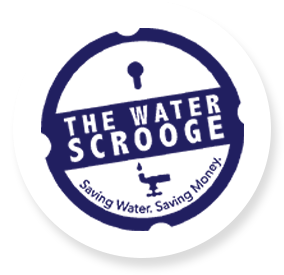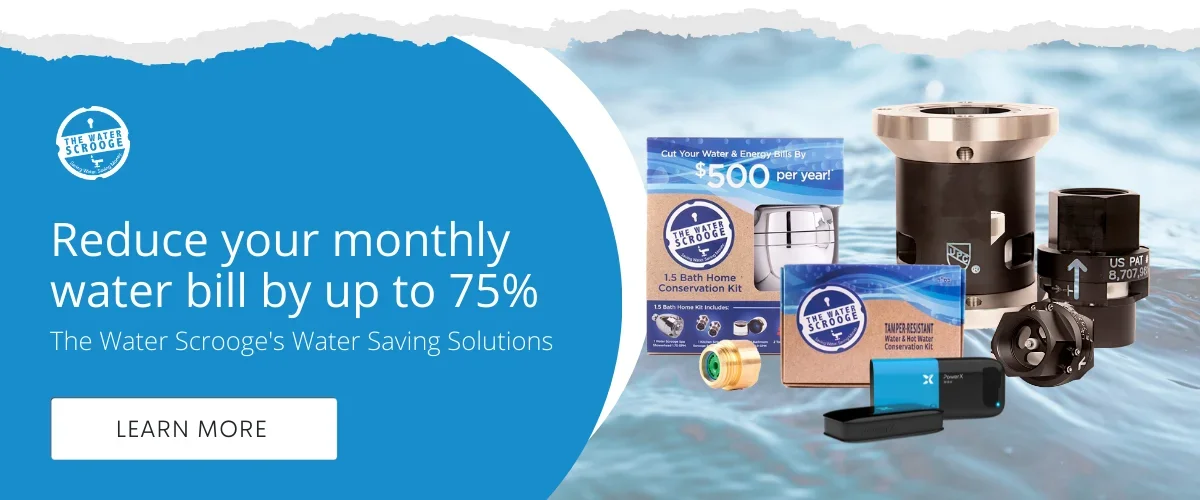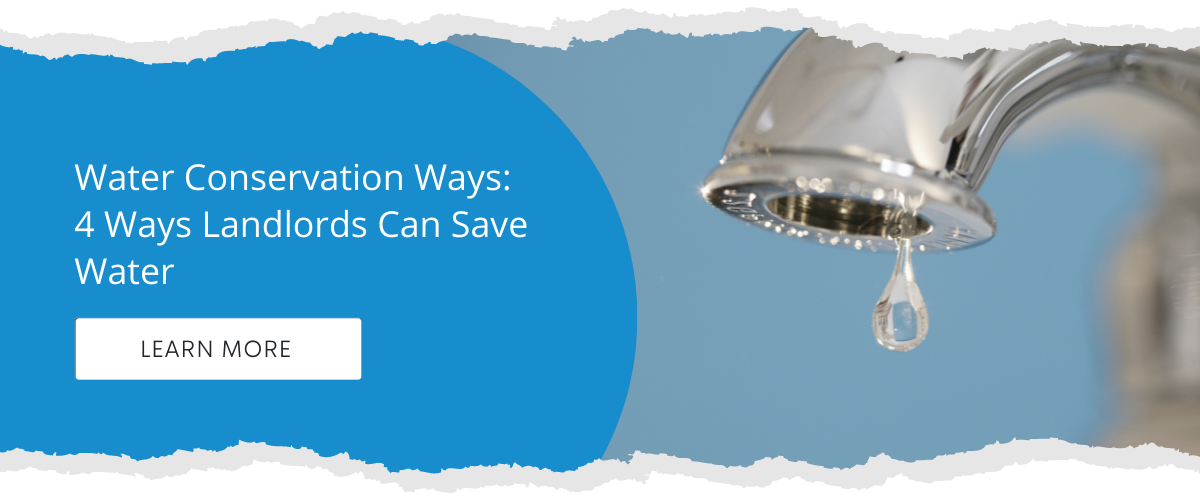6 min read
9 Types of Water Conservation Technologies Landlords Are Raving About
![]() David Schwartz
Mar 15, 2022 7:00:00 PM
David Schwartz
Mar 15, 2022 7:00:00 PM

The average American family of four uses about 400 gallons of water per day. 80% of the country by region, anticipate water shortages in the coming years. Worldwide, clean water shortages are among the most pressing humanitarian issues. Reducing household water consumption can not only lower multi-tenant landlords' utility bills, but can also have a significant impact on the environment.
Fortunately, there are several different methods of water conservation that landlords can implement to combat water leaks, shortages and lower bills. From installing low-flow aerators in tenants’ kitchens and bathrooms to revisiting how you keep your landscaping lush and green, you have many options to cut back on your multi-family building’s consumption. Here's how:
- Shower Regulators
- Faucet Aerators
- Toilet Tank Fill Cycle Diverters
- Outdoor Irrigation Controls and Rain Sensors
- Soil Moisture Sensors
- Sprinkler Heads
- Toilet Leak Prevention Device
- Leak Detection System
- Water Flow Management Device
Technologies for Residential Water Conservation
For residential landlords of multi-tenant units, installing water conservation technologies can offer a host of benefits. By using faucet aerators, flush diverters, and other types of conservation technologies, it is possible to significantly reduce consumption without having a negative impact on tenant experience.
If your business goals include reducing utility bills, attracting new tenants, or creating a positive impact on your community, water conservation technology could be the right answer. Join us as we review nine cutting-edge technologies to reduce water usage that landlords will love.
01. Shower Regulators
The cost of your residents' daily showers is among the biggest drains on your utility budget. Not only does a 10-minute shower use approximately 30-50 gallons of water, but it can also spike natural gas bills due to the power necessary to heat water. Adopting a low-flow shower head can go a long way in curbing costs.
There are several forms of shower regulators available to residential landlords. While both low-flow shower fixtures and tamper-proof fixtures can reduce water usage during showers, it's important to ensure that low-flow regulators do not sacrifice tenant comfort.
In order to ensure that shower regulators protect conservation efforts, landlords have several options:
-
Tamper-proof fixtures: These options can only be removed by maintenance or other authorized personnel, due to a need for a special key to remove or modify the regulator.
-
Install a spa shower head: Low-flow spa shower heads are designed to maintain tenant comfort despite decreased water pressure. The resulting effect is luxurious, without the sky-high utility bills.
02. Faucet Aerators
Bathroom and kitchen sinks can be equipped with aerator technology. Aerators create a no-splash stream, due to the combining of water and air. This offers high water pressure without high water usage.
Investing in tamper-proof faucet aerators could be crucial to ensuring adoption in a multi-unit property. Some residents may find the mixed delivery of water and air annoying during hand washing, dishes, and other routine activities.
By purchasing faucet aerators that can be removed only with a special key, landlords can prevent tenants from removing the aerators as soon as maintenance is finished with installation.
Additionally, the quality of faucet aerators can go a long way in ensuring adoption and satisfaction. The Water Scrooge's tamper-proof faucet products can have a lower impact on tenant comfort than cheap aerators which cause splashing or uncomfortably low pressure.
03. Toilet Tank Fill Cycle Diverters
Fill cycle diverters reduce water utilization by diverting some water that would typically fill the toilet bowl to the tank. This technology uses less water for the toilet bowl and tank, which can reduce water utilization by up to 1/2 gallon per flush. Some toilet tank diverters offer multiple configurations, which can include water level reduction.
Customizing fill cycle diverters allows landlords to make adjustments according to tenant needs or property management's preferences. In contrast, while toilet tank bags are among the lowest costs toilet technologies, they are relatively easy for tenants to remove.
Landlords should consider the importance of regular leak inspection on toilet tanks to facilitate ongoing cost savings. The Water Scrooge's white glove installation service includes toilet tank inspection for the presence of leaky toilets, increased water use per flush, as well as follow-up leak detection.
04. Outdoor Irrigation Controls and Rain Sensors
If your property requires outdoor watering to maintain landscaping, outdoor irrigation controls are a "smart" tool similar to the Nest thermostat. By using streams of weather satellite data on weather conditions specific to your outdoor area, smart sprinkler controllers can adjust watering to ensure rainwater is utilized while maintaining landscape health.
Automated sprinkler systems that go off during rainstorms are a poor use of precious water. In fact, most landscaping features don’t need to be watered for another two days after it rains, or until the top two inches of soil have dried. Luckily, outdoor irrigation controls have solved the problem of scheduled sprinklers doing nature’s job.
The first generation of these sensor-driven timers can be controlled from smartphone apps and include tools to monitor your water usage history. In cold climates like NYC, outdoor irrigation controllers can also adjust to below-freezing temperatures that can protect against irrigation system damage.
Rain sensors shut off scheduled outdoor irrigation or sprinkler systems when rainfall is detected, to prevent water usage. These connected devices rely on moisture sensors to prevent scheduled irrigation, such as lawn sprinklers that run on timers, from occurring. While these sensors will prevent watering during rainfall, they're not designed to increase watering during dry periods or respond to freezing temperatures.
The purpose and outcome of rain sensors and outdoor irrigation controls are pretty similar. However, landlords who need irrigation control should note that rain sensors don't require a wireless connection since their function isn't based on data streams from weather satellites. Another potential bonus is that rain sensors come at a much lower price point than smart irrigation controllers.
05. Soil Moisture Sensors
Soil moisture sensors are designed for garden beds, lawns, and other forms of outdoor landscaping. These sensors provide feedback to irrigation or sprinkler systems on how much watering is needed, based on detected soil moisture level.
06. Sprinkler Heads
Low-technology sprinkler heads can waste a great deal of water, due to uneven or ineffective water distribution. By using sprinkler heads with better coverage due to the size of water droplets, landlords can shorten run time by up to 35%, compared to traditional nozzles. If you are able to use rainwater or other forms of non-potable water for irrigation, you can further reduce water utilization.
07. Toilet Leak Prevention Device
Leaking toilet bowl tanks can be difficult to detect but can significantly raise water usage. A moderate toilet leak wastes about 6,000 gallons per month. A more severe leak tack on a few hundred dollars to your water bill while squandering thousands more gallons of H2O.
Instead of installing a leak detection sensor on each toilet, which is expensive and, most supers won't do the work of fixing toilet leaks, why not go with a leak prevention device or a valve that will fix 80% of your leaks?
Unlike other leak detection solutions in the market, the Toilet Scrooge™ leak prevention device actually prevents leaks, instead of just detecting them. The Toilet Scrooge™ device uses a motion sensor that opens up a valve to let water flow to the toilet when a user is present.
The sensor tells the valve when to open, allowing water to flow to the toilet. After the user leaves, the valve closes, which prevents water from continuing to flow and wasting water for a leaky toilets. No water flow means no continuous leaking!
08. Leak Detection System
Being that leaks are spontaneous and impossible to predict, finding leaks before they cause major damage is vital. Most leak detectors in the market are usually battery-operated discs or small square boxes that can be easily installed and placed on the floor where you could suspect a possible water leak. Unfortunately, not all leaks are created equal and there’s always the possibility that the leak won't just be on the floor.
A great, well-engineered solution that is revolutionizing the leak detector market is the Water Scrooge™ Leak Detection System. The Water Scrooge™ Leak Detection System has an ultrasound sensor that is clamped to the building's water risers and communicates to the system's hub, transmitting the data collected from the sensors to your smartphone in real time.
The Water Scrooge™ Leak Detection System doesn't even require a plumber, making it super easy for landlord's to install. Once the system is clamped on the riser, you can sync it with an app to get a bird’s eye view of all the water fixtures in your building.
09. Water Flow Management Device
Every time we take a shower, flush a toilet or let the sink run it causes the pressure to drop, therefore increasing the volume of air. Water meters that measure by volume, use the method known as Positive Displacement. This is the most common method used to measure water consumption, which measures the total volume read, including both water and air.
By using water conservation technologies such as a water flow management device, like The Water Scrooge™, you can compress the air before it reaches the water meter. As a result, your water meter measures only the water volume and no excess air.
The Water Scrooge's SMART VALVE™ is designed by engineers to be installed in an existing pipe joint on the user side of the water meter and can be easily installed by any licensed plumber, eliminating water meter inaccuracy and excessive water consumption.
It Pays to Conserve
Balancing tenant comfort and preferences with available technologies for water conservation should be a priority for residential landlords in 2022. By taking advantage of the best offerings to control residential water use, including tamper-proof technologies and offerings designed with comfort in mind, landlords can reduce their water bills without sacrificing resident happiness.
The Water Scrooge™ offers patented, tamper-proof fixtures for showers and sinks and a water flow management device that is designed to create a minimal impact on residents experience. Our multi-tenant kits include shower flow controllers, sink aerators, toilet fill cycle converters, leak detection tablets, and more. As a matter of fact, our clients save an average of $500 per unit per year thanks to The Water Scrooge.
To learn more about these multi-tenant kits or our Water Consulting Services, click here.
About The Water Scrooge™
The Water Scrooge™ offers water conservation ways and products to multi-family landlords and homeowners, including: shower flow controllers, Leak Detection Systems, Toilet Leak Prevention Devices (The Toilet Scrooge™), water flow management devices (SMART Valve™), toilet calibration and DIY products.
Also featuring The Water Scrooge™ App. Our app empowers your team to carry out the installation of our kits. With it, you can also record and track data points about the units (other than water usage).




